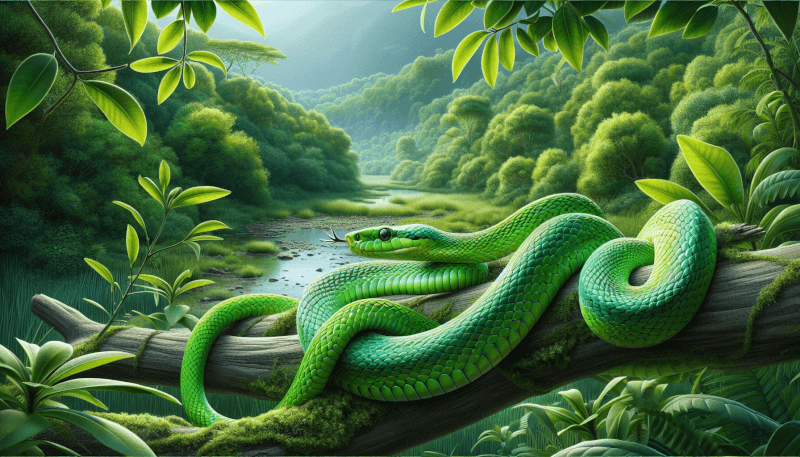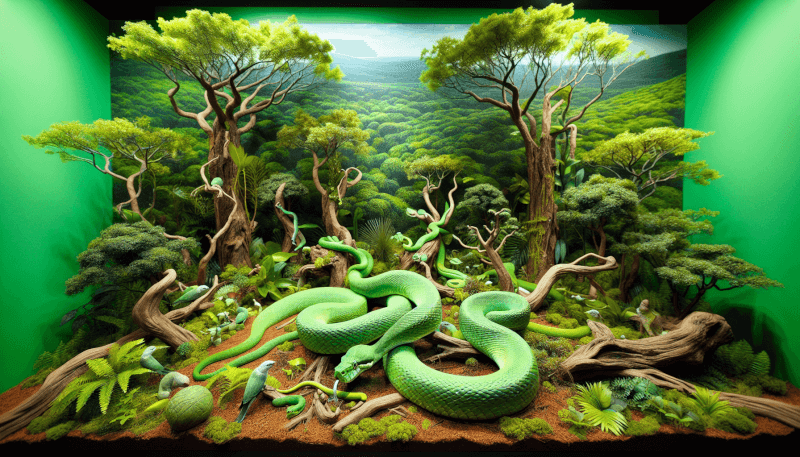Are you ready to learn about the captivating world of African Green Bush Snake care? This article will provide you with all the essential information you need to ensure the health and happiness of these fascinating reptiles. From their habitat requirements to their dietary needs, we’ll explore every aspect of caring for African Green Bush Snakes, helping you become a knowledgeable and responsible snake owner. So let’s embark on this exciting journey together and discover the secrets of providing excellent care for these beautiful creatures.

Housing
Choosing an enclosure
When it comes to housing your African Green Bush Snake, there are a few factors to consider. The enclosure should provide enough space for the snake to move around comfortably, but not so large that it becomes difficult for the snake to find its food. A glass terrarium with a secure lid is a popular choice for these snakes, as it allows for easy visibility and temperature control.
Size of the enclosure
The size of the enclosure will depend on the size of your snake. As a general rule of thumb, the enclosure should be at least as long as the snake’s body length and about half as wide as the snake is long. This will ensure that the snake has enough room to stretch out and explore its environment.
Temperature gradient
Maintaining a proper temperature gradient within the enclosure is crucial for the health and well-being of your African Green Bush Snake. The enclosure should provide a temperature gradient, with one end of the enclosure being warmer than the other. The warm end should have a basking spot with a temperature of around 85-90°F (29-32°C), while the cool end should be kept around 75-80°F (24-27°C). This temperature gradient allows the snake to regulate its body temperature by moving between the warmer and cooler areas of the enclosure.
Humidity levels
African Green Bush Snakes come from tropical regions and require a higher humidity level than some other snake species. Aim for a humidity level of around 60-70%. This can be achieved by misting the enclosure regularly and providing a humid hide for the snake to retreat to when it needs extra humidity. Monitoring humidity levels with a hygrometer is important to ensure that the snake’s needs are being met.
Feeding
Dietary requirements
African Green Bush Snakes are carnivorous and primarily eat small vertebrates such as lizards, frogs, and small birds. It is important to offer a varied diet to ensure that your snake receives the necessary nutrients. Feeder items should be appropriately sized for the snake, typically no larger than the snake’s thickest part. It is recommended to feed pre-killed prey to minimize the risk of injury to the snake and to avoid any parasites or diseases that may be present in live prey.
Feeding frequency
Young African Green Bush Snakes will need to be fed more frequently, usually every 4-5 days. As the snake grows, the feeding frequency can be gradually decreased to every 7-10 days for adults. It is important to find the right balance and monitor your snake’s body condition to avoid overfeeding or underfeeding.
Prey size
Feeder items should be appropriately sized for the snake. The size of the prey should be approximately the same width as the snake’s thickest part. This ensures that the snake can easily swallow and digest its food without any issues.
Handling live prey
While some snake species will only eat live prey, it is generally safer and more convenient to feed African Green Bush Snakes pre-killed prey. This eliminates any risk of injury to the snake and reduces the likelihood of parasites or diseases being introduced into the enclosure. Pre-killed prey can be purchased from pet stores or online, and it is important to thaw it out fully before offering it to the snake.
Lighting and Heating
UVB lighting
UVB lighting is important for African Green Bush Snakes as it helps them metabolize calcium and prevents issues such as metabolic bone disease. Providing a UVB light source in the enclosure is essential, along with a heat source to create a basking spot.
Basking temperature
A basking spot with a temperature of 85-90°F (29-32°C) should be provided in the enclosure. This allows the snake to raise its body temperature and aids digestion. Use a heat lamp or a ceramic heat emitter to create the basking spot, ensuring it is securely mounted and out of the snake’s reach.
Ambient temperature
In addition to the basking spot, it is important to maintain an ambient temperature throughout the enclosure. The cool end of the enclosure should be kept around 75-80°F (24-27°C) to allow for thermoregulation. Using a thermostat or heat regulator can help maintain a consistent temperature.
Heating options
There are various heating options available for maintaining the temperature in your snake’s enclosure. Heat pads, heat tape, ceramic heat emitters, and heat lamps are all options to consider. It is important to choose a heating option that provides a safe and consistent heat source for your snake.
Water and Hydration
Providing a water source
African Green Bush Snakes require access to fresh, clean water at all times. A shallow water dish should be provided in the enclosure, large enough for the snake to soak in if desired. Make sure to clean and refill the water dish regularly to ensure freshness.
Misting the enclosure
In order to maintain the necessary humidity levels, it is important to mist the enclosure regularly. Use a spray bottle filled with dechlorinated water to mist the enclosure, focusing on the substrate and any plants or hides. This will help create a moist environment for the snake.
Humid hides
In addition to misting the enclosure, providing a humid hide can help your African Green Bush Snake shed its skin more easily. A humid hide can be created by placing a moss-filled container or a damp hide box in the enclosure. This will provide a sheltered area with higher humidity for the snake to retreat to when needed.

Substrate
Choosing the right substrate
There are various substrate options available for your snake’s enclosure. Some suitable options for African Green Bush Snakes include coconut fiber, cypress mulch, or a mixture of sphagnum moss and reptile bark. Avoid using substrates that can be ingested by the snake and may cause impaction, such as sand or gravel.
Depth and texture
The depth of the substrate will depend on the snake’s size and natural habitat. A 1-2 inch layer is usually sufficient for African Green Bush Snakes. The texture of the substrate should be comfortable for the snake to move on and burrow in if desired.
Substrate cleaning
Regular cleaning of the enclosure is important to maintain cleanliness and prevent the build-up of bacteria or parasites. Spot cleaning should be done as needed to remove any waste or soiled substrate. A complete substrate change should be done every 2-3 months or as necessary.
Enrichment and Hides
Branches and climbing structures
African Green Bush Snakes are arboreal and enjoy climbing. Adding branches or climbing structures to the enclosure will provide opportunities for exercise and stimulation. Make sure the branches are securely placed to avoid any accidents or injuries.
Hiding spots
Hiding spots are essential for any snake enclosure. Provide multiple hiding spots throughout the enclosure using suitable hides or small caves. This gives the snake a sense of security and allows it to retreat and feel safe.
Artificial plants
Adding artificial plants to the enclosure can create a more natural and visually appealing environment for your snake. Choose plants that are non-toxic and easy to clean. These plants can also provide additional hiding spots and climbing opportunities.
Environmental stimulation
African Green Bush Snakes benefit from environmental stimulation to keep them mentally and physically active. This can include introducing new decor, rearranging the enclosure, or providing interactive toys and puzzles. Regularly changing the environment will prevent boredom and promote a healthier snake.
Handling and Behavior
Handling techniques
When handling your African Green Bush Snake, it is important to approach them calmly and gently. Start by supporting their body and allow them to explore your hands. Always ensure that your hands are clean, as any strong smells on your hands may stress or alarm the snake.
Temperament and behavior
African Green Bush Snakes are generally secretive and shy by nature. They may be more inclined to hide or retreat when handled, which is normal behavior. However, with regular handling and patience, they can become more comfortable and relaxed with human interaction.
Signs of stress or illness
It is important to closely observe your snake for any signs of stress or illness. Some common indicators include loss of appetite, lethargy, abnormal shedding, or changes in behavior. If you notice any concerning symptoms, it is recommended to consult a reptile veterinarian for a thorough examination and appropriate treatment.
Healthcare and Regular Checkups
Finding a reptile veterinarian
Finding a reptile veterinarian who specializes in snakes is crucial for the well-being of your African Green Bush Snake. They will be able to provide important information, routine health checks, and treatment if necessary. Consult with local reptile clubs or trusted online sources to find a reptile veterinarian in your area.
Routine health checks
Regular health checks by a reptile veterinarian are recommended to ensure the overall health of your snake. A thorough examination may include checking for parasites, evaluating body condition, and discussing any concerns or behavioral changes.
Common health issues
Some common health issues that can affect African Green Bush Snakes include respiratory infections, external parasites, and digestive problems. Regular health checks, proper husbandry, and prompt veterinary care can help prevent and address these issues.
Parasite prevention
Parasite prevention is important for the overall health of your snake. Regular fecal examinations by a veterinarian can help detect and treat any potential internal parasites. Quarantining new snakes before introducing them to an existing collection is also important to prevent the spread of parasites.
Breeding and Reproduction
Sexing your snake
Determining the sex of your African Green Bush Snake is essential if you are considering breeding. Males and females have differences in size, tail shape, and spurs. Consult with an experienced breeder or reptile veterinarian to ensure accurate sexing.
Breeding setup
Creating a suitable breeding setup involves providing different temperature and lighting conditions to stimulate the breeding process. Consult with experienced breeders, reptile forums, or reptile breeding guides for specific guidelines on creating a successful breeding setup.
Incubation and hatching
After successful breeding, the female will lay eggs which need to be incubated under controlled conditions. A separate incubator with precise temperature and humidity settings is necessary to ensure proper development and hatching of the eggs. Monitor the incubator regularly and consult with experienced breeders or reptile forums for guidance.
Caring for hatchlings
Once the eggs hatch, it is important to provide appropriate housing and care for the hatchlings. This includes providing suitable enclosures, proper temperature and humidity, and feeding them a diet of appropriately sized prey. Regular monitoring and adjustments to the hatchlings’ environment will ensure their healthy growth and development.
Conclusion
In summary, African Green Bush Snakes require specific care to thrive in captivity. Providing an appropriate enclosure with the right temperature gradient, humidity levels, and substrate is essential for their well-being. Feeding a varied diet of appropriately sized prey and ensuring proper lighting and heating are also important factors. Regular monitoring of health, handling with care, and providing enrichment and hides will help keep your African Green Bush Snake happy and healthy for years to come. Remember to consult with experienced reptile veterinarians and breeders for specific guidance and advice tailored to your snake’s needs.


